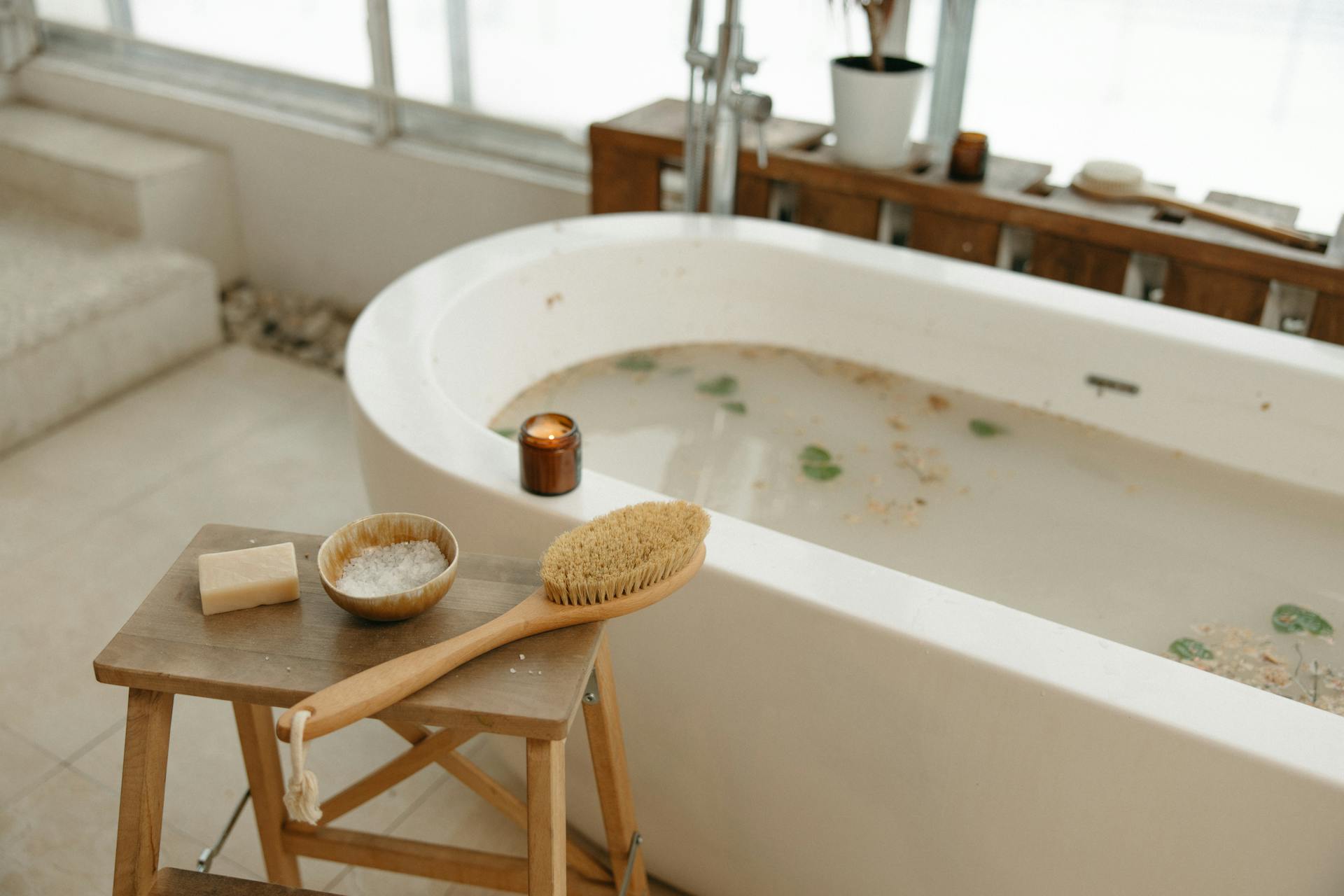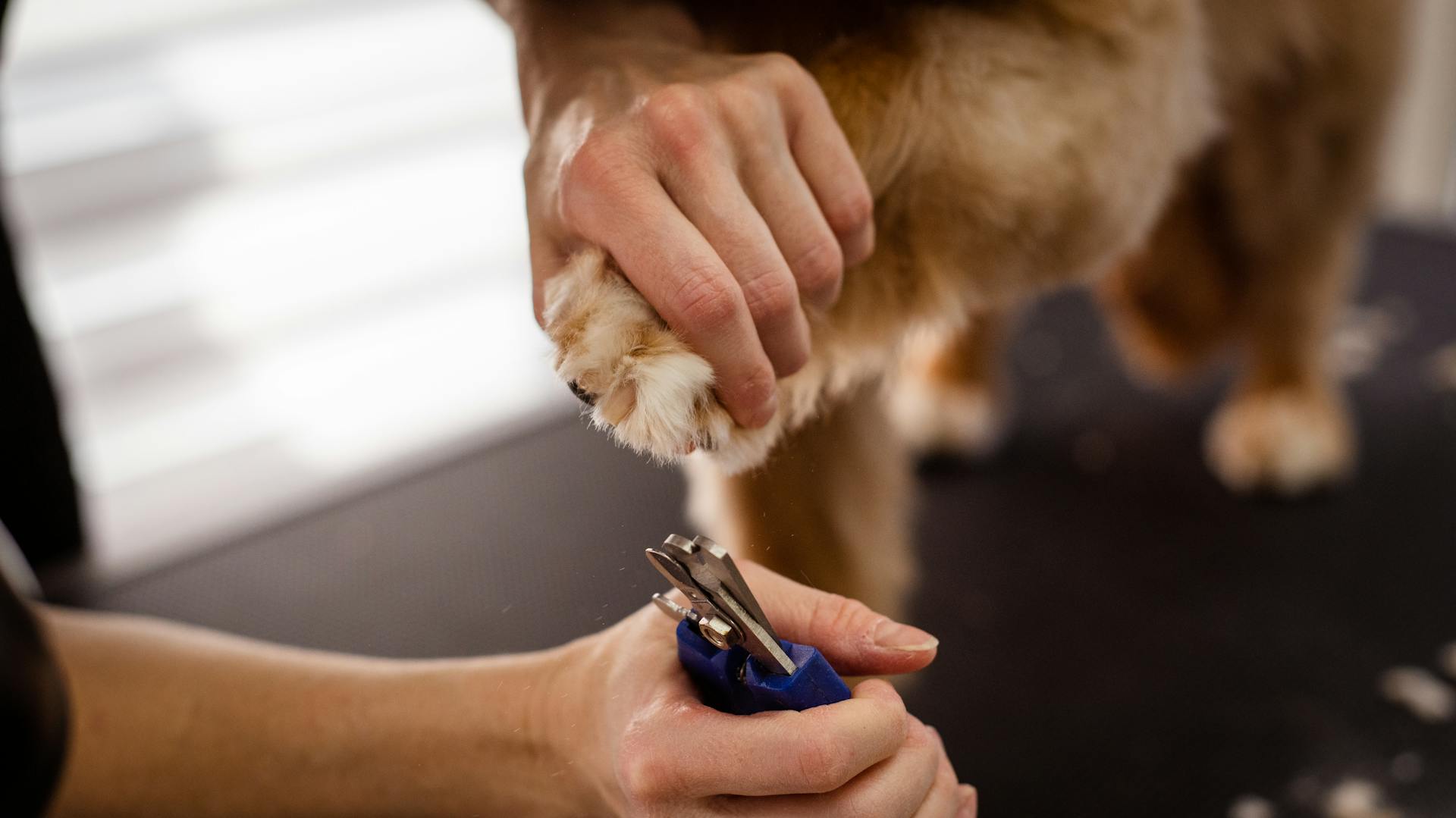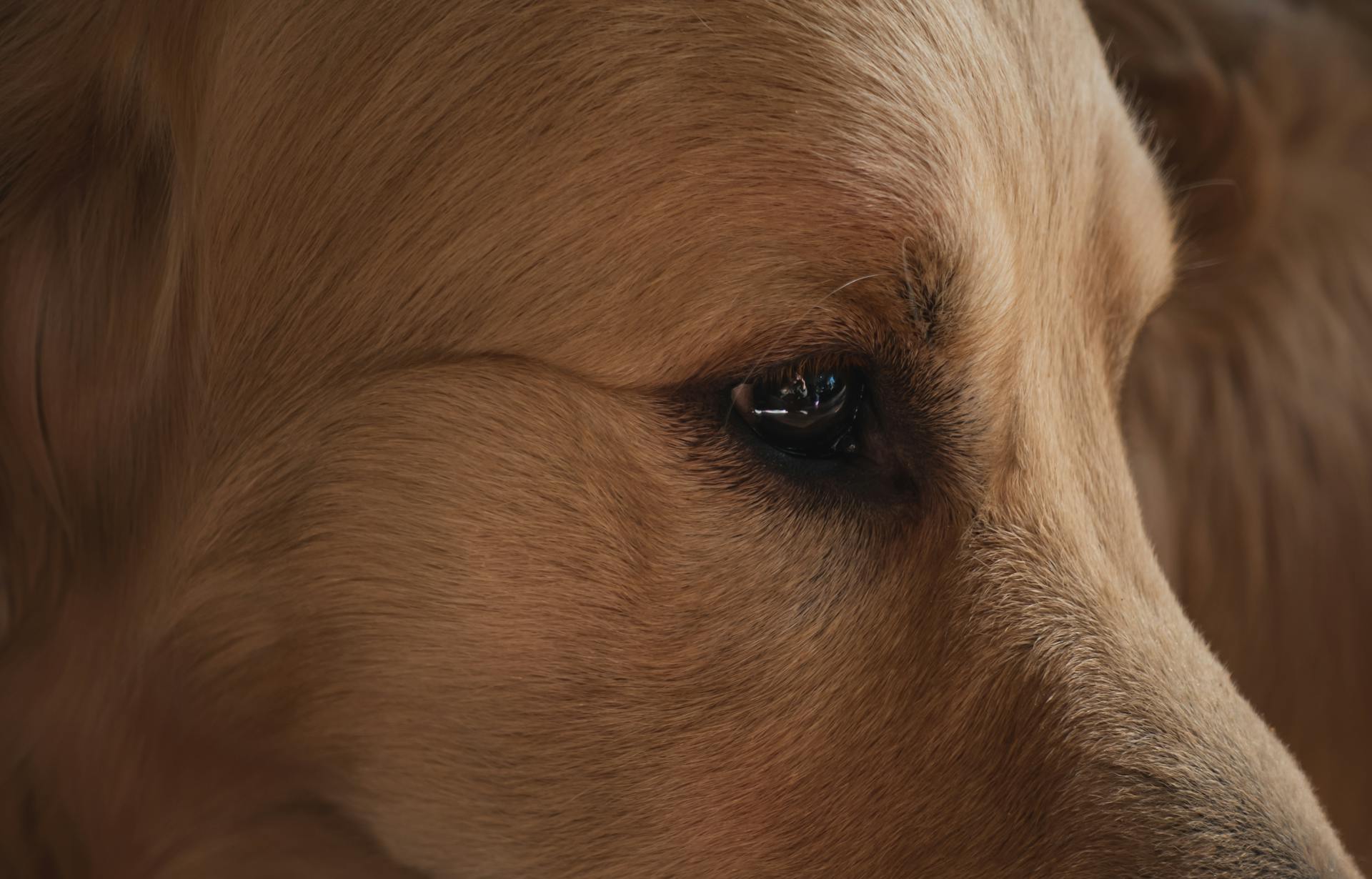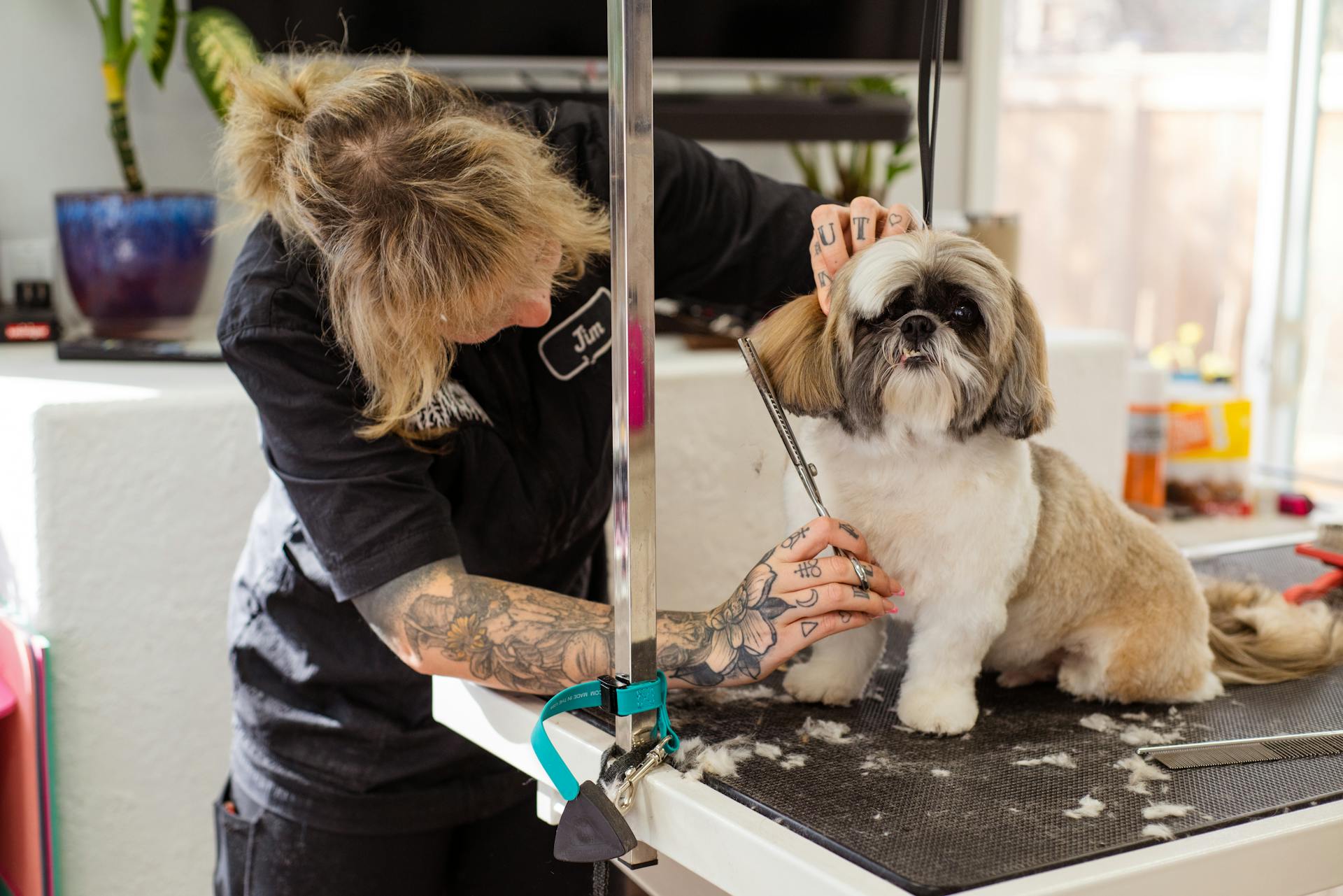
Grooming a dog is an essential part of their overall health and well-being. Regular grooming helps prevent matting and tangling of their fur, which can be painful and even lead to skin infections.
To start, brush your dog regularly to prevent matting and tangling of their fur. Brushing also helps to distribute skin oils, keeping their coat healthy and shiny.
The frequency of brushing depends on your dog's coat type, with long-haired dogs needing to be brushed daily and short-haired dogs needing to be brushed weekly. Brushing your dog before a bath can also help prevent matting.
Bathing your dog is an important part of their grooming routine. The frequency of bathing depends on your dog's lifestyle, with dogs that spend a lot of time outdoors needing to be bathed more frequently than dogs that stay indoors. A general rule of thumb is to bathe your dog every 2-3 weeks.
Broaden your view: Do Long Haired Chihuahuas Shed
Pre-Grooming
Before you start grooming your dog, it's essential to gather all the necessary supplies. Here's a list of what you'll need:
- Brush
- Nail trimmers
- Clotting powder
- Ear cleaner
- Cotton balls or gauze
- Washcloth and warm water
- Dog toothbrush and toothpaste
- Shampoo
- Towels
- Treats (or another reward)
You should schedule a grooming session after your dog has had plenty of exercise to minimize the wiggles.
Bathe Your Dog as Needed
Bathing your dog as needed is crucial for their overall health and well-being. Regular baths can help prevent skin problems and keep their coat clean and healthy.
Some breeds, like Shar Peis and Pugs, require special attention when it comes to bathing. These breeds have loose facial skin or wrinkles that can trap dirt and bacteria, leading to irritation and infection. To prevent this, clean the folds with damp cotton and always thoroughly dry the areas between the folds.
Labradors, for example, should not be bathed too often. Their coats contain a natural oil balance that keeps them healthy and water-resistant, and frequent baths can remove these oils, leading to dry skin and other complications. Unless your Labrador has a skin condition that requires medicated baths, bathing too often is not recommended.
If you do need to bathe your dog, use a dog-friendly shampoo and avoid getting soap in their eyes. Rinse your dog thoroughly after the bath and dry them with old towels.
Related reading: How Often Dog Grooming
Coat and Fur Care
Grooming your dog's coat and fur is an essential part of their overall health and well-being. Regular brushing will help keep their hair in good condition by removing dirt, spreading natural oils, and preventing tangles and mats.
To determine how often to brush your dog, consider their coat type. Dogs with smooth, short coats like Chihuahuas and Boxers need only a weekly brush, while those with long, silky coats like Yorkshire terriers require daily attention.
Daily brushing will also help prevent mats in long-haired dogs, especially those with coats like a collie's or an Afghan hound's. For these breeds, gently tease out tangles with a slicker brush, and then brush their coat with a bristle brush.
Some dogs, like Labradors, shed heavily and need to be brushed 2-3 times per week, or daily during shedding season. Brushing firmly but gently is essential to avoid damaging their skin.
Here's a quick guide to help you determine the right brush for your dog's coat:
- Longhaired dogs need pin brushes
- Short-, medium-, and some long-coated breeds need bristle brushes
- Slicker brushes are great for removing mats and dead hair
- Rubber curry combs are perfect for polishing smooth coats and removing dead hair
Remember to always check for burrs, mats, and any cuts or scrapes on your dog's skin while brushing. Regular brushing will also help keep shedding under control, making your dog's coat look shiny and healthy.
Expand your knowledge: When You Step on Your Dog's Paw?
Shedding and Trimming
Shedding is a natural process for dogs, but it can be reduced with regular brushing. Ask your veterinarian or groomer to recommend a brush or comb that suits your dog's hair type. You can also reduce shedding by keeping your dog indoors, but be aware that they may still shed fairly evenly throughout the year.
To prevent excessive hair loss, ensure your dog is getting the right nutrients from their food. Quality pet-food manufacturers work hard to include the right nutrients, but pets with allergies or sensitivities may need to try different brands to find one that works for them.
Excessive shedding can be a sign of underlying health issues, such as parasites, fungal or bacterial infections, or skin allergies. If you notice any of the following conditions, consult with your veterinarian for treatment: skin irritation, open sores, bald spots, dull and dry hair, scratching, or constant foot licking or face rubbing.
Here are some common causes of excessive shedding:
- Parasites (fleas, lice or mites)
- Fungal or bacterial infections
- Inhalant- or food-related allergies
- Kidney, liver, thyroid or adrenal disease (including Cushing’s)
- Pregnancy or lactation
- Certain medications
- Self-induced trauma due to licking
- Cancer
- Immune disease
- Sunburn
- Contact with irritating or caustic substance
Regular nail trimming is also essential for your dog's health and comfort. Most dogs need a nail trim every 3-4 weeks, and it's best to trim the part of the nail that turns down, avoiding the quick.
Related reading: Dog Nail Grooming
Cutting Dog Fur
Before you start cutting your dog's fur, it's essential to brush, bathe, and thoroughly dry them. This will make the process much smoother and safer for both you and your dog.
To begin, use blunt-ended shears or small clippers with guide combs to trim hair that's covering your dog's eyes, long hair covering private parts, and hair between their paw pads, if needed. A number 10 blade may work best in delicate areas.
You should also consider watching an informational YouTube video from a reputable groomer to learn the best techniques. This will help you feel more confident and prepared.
If you're comfortable with it, you can then perform a light overall trim, keeping the blades far away from your dog's skin. A number four blade may work best for an overall trim.
Recommended read: Dog Grooming Blade Sharpener
How Often to Trim My Dog's
Most dogs need a nail trim every 3-4 weeks to prevent pain and damage to their paws.
Trimming your dog's nails too short can lead to bleeding, so it's essential to be cautious and only trim the part of the nail that turns down.
You can use a sharp nail clipper or a Dremel grinder, whichever you and your dog prefer, but make sure to choose the right size for your dog.
Trimming one nail a day and following it with a treat and praise can help your dog get used to the process.
If your dog's nails click on the floor or look too long, it's time for a trim.
You can use nail trimmers or a nail grinder to trim your dog's nails, and if you're unsure, ask your vet or groomer for a tutorial.
Remember, your dog's nails can bleed if you cut them too short, so keep clotting powder on hand if needed.
It's better to trim your dog's nails regularly than to let them grow too long, which can interfere with their gait and make walking painful.
If this caught your attention, see: How to Trim a Dachshunds Nails
Shedding
Shedding is a natural process for dogs, and the amount and frequency of hair shed often depends on their health, breed type, and season. Many dogs develop thick coats in the winter that are then shed in the spring.
Dogs who are always kept indoors tend to shed fairly evenly all year, while those with thick coats may shed more noticeably. Regular brushing can help reduce the amount of hair in your home.
You can reduce shedding by brushing your dog regularly, but it's essential to use the right type of brush or comb for your dog's hair type. Ask your veterinarian or groomer for recommendations.
Excessive shedding can be a sign of underlying health issues, including parasites, fungal or bacterial infections, and allergies. If you notice any of these conditions, consult with your veterinarian for treatment.
Here are some common causes of excessive shedding:
- Parasites (fleas, lice or mites)
- Fungal or bacterial infections
- Inhalant- or food-related allergies
- Kidney, liver, thyroid or adrenal disease (including Cushing’s)
- Pregnancy or lactation
- Certain medications
- Self-induced trauma due to licking
- Cancer
- Immune disease
- Sunburn
- Contact with irritating or caustic substance
If you notice any of the following conditions, consult with your veterinarian for treatment:
- Skin irritation, including redness, bumps, rashes or scabs
- Open sores of any kind
- Bald spots or thinning of coat
- Dull, dry hair that pulls out easily
- Scratching
- Constant foot licking or face rubbing
Dental and Eye Care
Brush your dog's teeth as frequently as possible, ideally up to twice a day, to prevent gum disease.
Plaque hardens to tartar in just a few days, and tartar can only be removed during a professional teeth cleaning by a veterinarian.
Use a soft toothbrush and toothpaste made specifically for dogs, never human toothpaste which can be toxic.
Small dogs are especially prone to teeth issues due to their crowded teeth.
Gently wipe away any eye discharge in the corners with a cotton ball or soft washcloth moistened with warm water.
Ear Cleaning
Ear cleaning is an essential part of your dog's regular grooming routine. It's especially important for dogs who produce excessive earwax or have a lot of inner-ear hair.
To clean your dog's ears, use a cotton ball or piece of gauze dampened with mineral oil, hydrogen peroxide, or a liquid ear cleaner specifically formulated for this purpose. Don't insert anything into your dog's ear canal, as this can cause trauma or infection.
You might like: Dog Ear Grooming

You should clean your dog's ears once a month or more often if they're prone to ear problems. Clean the outer part of the ear only, using a damp cloth or a cotton ball soaked in mineral oil. Never force anything into the ear.
Some dogs need the hair plucked just inside the ear to keep air circulating, so ask your veterinarian if this is necessary for your dog. When cleaning your dog's ears, take a good look inside and smell each ear and ear canal for signs of infection.
Here are some warning signs of an ear infection to watch out for:
- Ear discharge
- Bad smells
- Redness
- Swelling
- Crusty skin
- Hair loss
If you notice any of these symptoms, contact your veterinarian right away. Regular ear cleanings can help reduce the chance of infection, so aim for about once a week unless your vet suggests doing it more often.
Eye Care
Eye care is an essential part of your Labrador's grooming routine. Regular eye checks can help prevent and detect eye problems early on.
Check this out: Dog Eye Irritation after Grooming

To check for redness or irritation, gently wipe away any discharge in the corners with a cotton ball or soft washcloth moistened with warm water. Make sure not to rub the cotton ball directly over the eye.
If you notice any signs of eye problems, such as discharge, redness, or swelling, contact your veterinarian right away. Eye issues can worsen quickly and should not be neglected.
Here are some signs to watch out for during eye care:
- Discharge
- Redness or swelling
- Pain
Nail Trimming
Trimming your dog's nails is a crucial part of their overall health and well-being. Most dogs will need a nail trim every 3-4 weeks.
Long nails can interfere with your dog's gait, making walking painful or awkward. They can also break easily, especially at the base of the nail.
You can use a sharp nail clipper or a Dremel grinder to trim your dog's nails. It's essential to choose the right size clipper for your dog.
Curious to learn more? Check out: How to Cut a German Shepherds Nails
Trim the part of the nail that turns down and avoid the quick, which will bleed if cut. Keep a styptic pencil on hand to stop any accidental bleeding.
If your dog has dark nails, trim only a little at a time until you see evidence of the quick in the center of the nail, then stop. This will help you avoid cutting the quick.
Getting your dog used to having their feet handled in puppyhood can make nail trimming a painless procedure. Start trimming gently, a nail or two at a time, and your dog will learn that you're not going to hurt them.
If you accidentally cut the quick, stop the bleeding with some styptic powder. You can also use clotting powder on hand if needed.
You can hear when your dog's nails are too long - they'll click on the floor. If you hear this, it's time for a trim.
A different take: Dog Grooming Powder
Dental Care

Brushing your dog's teeth is one of the most important aspects of their dental care. You should aim to brush their teeth as frequently as possible, ideally up to twice a day.
Plaque hardens to tartar in just a few days, so it's essential to brush their teeth regularly to prevent gum disease. This can lead to serious health issues like heart disease, kidney disease, and more.
Small dogs are especially prone to teeth issues, as their teeth tend to be more crowded than larger dogs. This makes regular brushing even more crucial for their oral health.
Use a soft toothbrush and toothpaste made specifically for dogs, as human toothpaste can be toxic to them. Never use human toothpaste on your furry friend.
Dental treats can help reduce plaque buildup, but only if your dog takes enough time to really chew the treat before swallowing it. Inedible dental chews can also help, but neither are a substitute for regular teeth brushing.
As your dog gets older, they may have a buildup of tartar that requires special cleaning by a veterinarian. Regular brushing can help prevent this and save you from costly dental work as the dog ages.
A unique perspective: How Often Can I Use Flea Shampoo on My Dog
Frequently Asked Questions
What are the 7 steps of grooming a dog?
To keep your dog clean and healthy, follow these 7 essential grooming steps: brush their coat, trim their hair, trim their nails, check their skin and ears, and bathe them sparingly. By following these simple steps, you can help your dog feel relaxed and look their best.
Do you bath a dog before or after grooming?
You don't need to bathe your dog before grooming, but a quick bath may be necessary if they're extremely dirty or muddy. Typically, bathing occurs as part of the grooming process.
Sources
Featured Images: pexels.com


